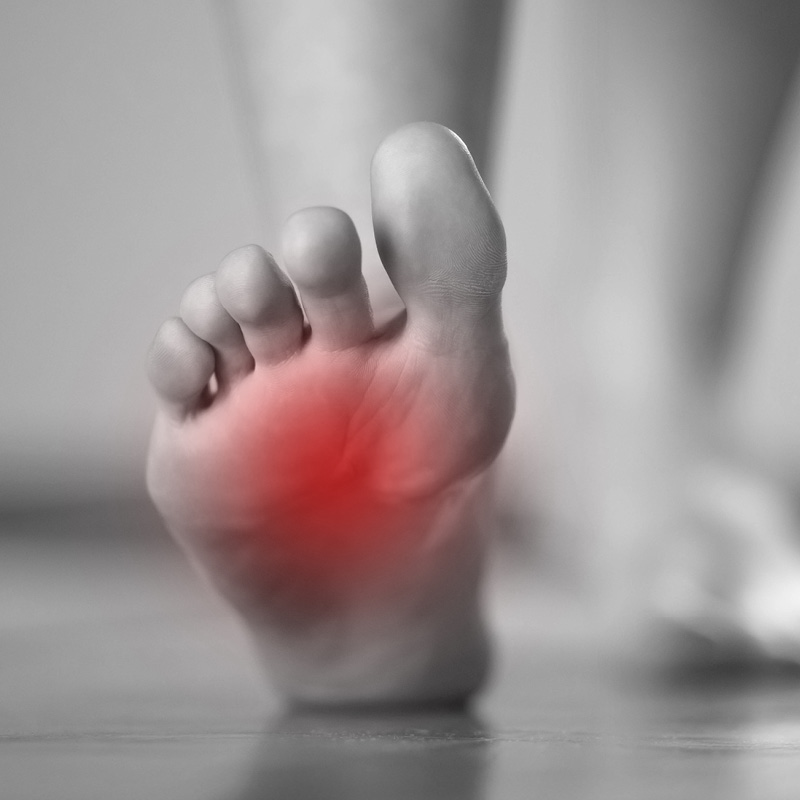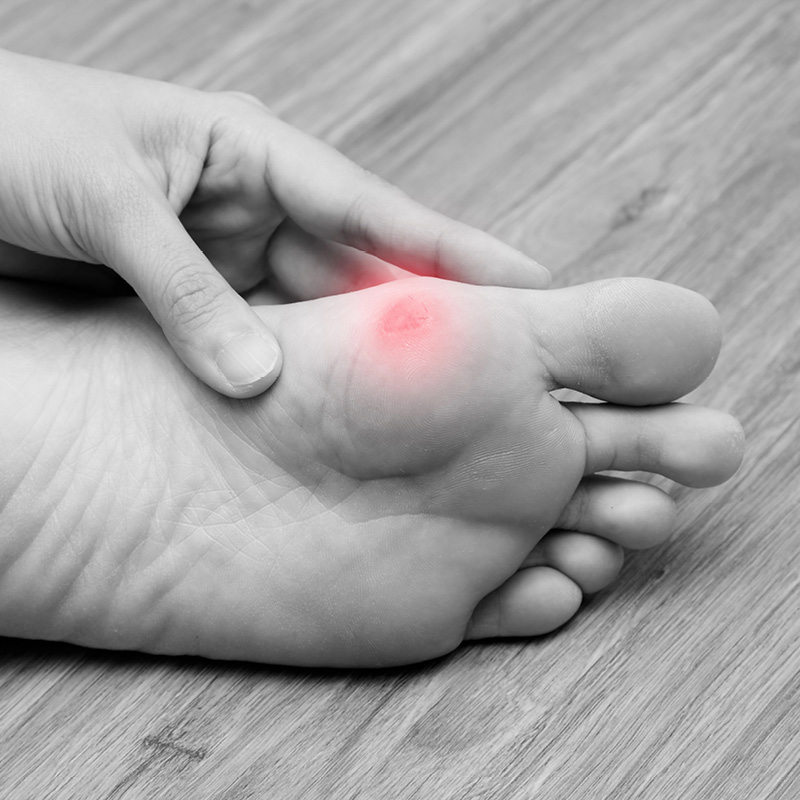Chiropody & Podiatry

What is podiatry?
Podiatry, formerly known as chiropody, is a branch of medicine that focuses on assessing, diagnosing, and treating conditions affecting the foot and lower limb. Regular podiatric maintenance can prevent complications and maintain your mobility. At The Wellhead Practice, our qualified podiatrists have extensive experience in foot and lower limb health care and are available for appointments every day of the week and alternate Saturdays.
Our practice covers professional management of:
- Nail care
- Callus removal
- Corn treatment
- Fungal treatments, such as athlete’s foot and fungal nail
- Pains in your feet or lower legs e.g. Plantar Fasciitis
- Diabetic foot care & Assessments
- Nail surgery for treating persistent in-growing toenails and
- Joint steroid injections
Podiatry services at The Wellhead Practice
At The Wellhead Practice, our HCPC-registered podiatrists are dedicated to foot health care. Each member of our foot health team has a Podiatry degree, which involves 3 years of training and approximately a thousand hours of practical training. They also have state registration and professional indemnity. The NHS recognises this qualification as equipping a podiatrist with extensive foot and lower limb knowledge.
Our Podiatrists are trained in vascular assessment, diabetic care and management, skin conditions, medication, life support and local anaesthetic injections. They maintain these standards with stringent annual continued professional development (CPD) training.
Cross infection standards are important to us and we work in an audited, clean environment, with instruments that are cleaned to full industry standards (sterilised in vacuum sealed bags at high temperatures) to provide the highest quality and safest environment for our patients.
Benefits of podiatry care for core conditions
Routine Podiatry - Nail Care, Corns & Callus:
A foot corn and a callus are common skin conditions caused by friction and pressure. Foot corns are thickened skin layers, usually appearing on toes, while calluses form on the soles. Both can cause discomfort and pain. A podiatrist treats foot corns and calluses through various methods. They may use debridement to gently remove the thickened skin, prescribe customized orthotics to reduce pressure, and recommend appropriate footwear. Regular podiatric care helps prevent recurrence, ensuring healthier, pain-free feet. Visit a podiatrist for effective corn and callus treatment.
Pathological Nails- Onychomycosis, Onychauxis, Onycholysis Or Involuted:
A pathological nail, also known as an abnormal or diseased nail, often presents with issues like fungal infections, ingrown nails, thickening, discoloration, or deformity. Podiatrists are specialised foot clinicians who diagnose and treat these conditions. Treatment options vary depending on the issue and may include trimming and debriding the nail, antifungal medications, corrective nail surgery, and patient education on proper foot hygiene. For chronic or severe cases, advanced procedures such as laser therapy or partial nail avulsion might be recommended. Regular visits to a podiatrist ensure early detection and effective management of pathological nails, promoting overall foot health.
In Growing Toe Nails (IGTN) & Requiring Nail Surgery:
In growing toenails, also known as onychocryptosis, occur when the toenail grows into the surrounding skin, causing pain, redness, and swelling. This condition often affects the big toe and can result from incorrect nail trimming, tight footwear, or injury. A podiatrist treats in growing toenails by first assessing the severity of the condition. Mild cases may be managed with proper nail care and footwear advice. For more severe or recurrent cases, nail surgery is often recommended. This procedure involves removing part or all of the affected nail under local anaesthesia, ensuring permanent relief and preventing future ingrowth.
Verruca:
A verruca, commonly known as a plantar wart, is a benign growth caused by the human papillomavirus (HPV) and typically appears on the soles of the feet. These warts can be painful and unsightly, often featuring a rough surface with small black dots. Podiatrists treat verrucae using various methods, including cryotherapy (freezing the wart), salicylic acid applications, needling and laser therapy. In some cases, minor surgical removal may be necessary. Podiatrists also provide advice on preventing verrucae, such as wearing footwear in communal areas and maintaining good foot hygiene. Timely professional treatment ensures effective and safe verruca removal.
Planter Heel Pain:
Plantar heel pain, commonly known as plantar fasciitis, is a condition characterised by sharp, stabbing pain in the heel, often experienced with the first steps in the morning. It is caused by inflammation of the plantar fascia, a thick band of tissue running across the bottom of the foot. A podiatrist treats plantar heel pain through a combination of methods, including custom orthoses to redistribute forces and reduce tissue stress on the plantar fascia, physical therapy to stretch and strengthen the foot and lower limb muscles. In some instances, extracorporeal shockwave therapy or surgery might be recommended to alleviate persistent pain.

Our Services
Our podiatrists have over 50 years of experience between them and aim to a provide a consistent high level of care by offering a wide range of services tailored to suit your needs.
If you struggle with any of these or have any other concerns about pain or the health of your legs or feet then please do get in touch.
- Struggling to cut your nails
- Painful or unsightly hard skin
- Irritating or painful corns
- Verrucae
- Discoloured nails
- Thickened nails
- Dry skin
- Athlete’s foot
- Painful ankles or toes*
- Painful soles or heels*
- Footwear advice
- Ankle or knee pain*
- Lower leg pain*
- Plantar Fasciitis
*If you are experiencing aches or pains in your lower legs/feet, we can also offer a hands on bio-mechanical assessment to find the potential cause of these problems.
What happens on my first visit?
Your Podiatrist will take a case history asking questions about your symptoms, general health, and past medical history. Please bring any prescriptions with you. Your podiatrist will then examine your feet and lower legs, carry out any additional assessments or tests needed and then discuss their diagnosis and treatment plan.
At the end of your consultation, the podiatrist will share with you any useful advice regarding exercises, stretching or the application of a suitable cream as appropriate. If you have been given a dressing, you will either be given a dressing appointment or advised on how to manage them. If you require any information to be written down, then please do ask.
No Nail Polish
Please avoid wearing nail polish/ varnish as these can hide possible signs of nail disease and can blunt our instruments too.
Wear Normal Shoes
Please wear your normal shoes and bring along any other shoes you routinely wear especially if you are having a biomechanical assessment for potential insoles.
Bring Details
Most private health insurers cover our services. Please bring all relevant authorisation codes and details of policy excesses to your appointment.
Informed Consent
Informed consent is important to us. We strive to make you feel comfortable and informed throughout the whole process. Please ask any questions and if you need clarification on any aspect of your consultation.
Please Ask Any Questions
If you have any questions or wish to discuss your problem with one of our practitioners first, they would be happy to speak with you on the telephone prior to booking an appointment.
Arrange Your Consultation
Contact us to arrange your appointment with one of our clinicians to see how we can help you.
